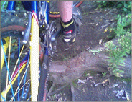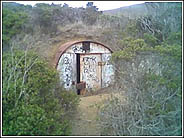 |
 |
April
26, 2005: The escape |
||||||
Continued from April 19, 2005: The wind From around the next clump of coastal bluff scrub came a powerful, crackling hum. It was an overwhelming sound that Rider #555 could feel reverberating in his chest. As all riders did, he understood what that sound meant: a Conservation remediation checkpoint.
Rider #555 knew he had about two seconds to react. A remediation checkpoint was essentially a giant, mobile, motion-sensitive Taser that the Conservation used to capture riders and commoners. Upon contact with a sensor field, the victim was incapacitated by a Taser charge, simplifying both capture and transport. Quickly, Rider #555 scrolled through his options. To stop, or even hesitate, meant certain capture. Continuing on his current trajectory would take him around the clump of brush to the open blufftop, and presumably straight into the checkpoint. To his right, a long finger of 50-foot high blufftop poked out towards the ocean -- a dead end. Behind him, the dust had barely settled on Cuz' Jimmy's grisly demise. Over to the left, he was completely closed out by a thick wall of pampas grass and bracken. If he could find some way to get down off the blufftop to the arroyos and coastal creeks of the freshwater marsh, he had a slight chance of finding some cover and evading capture. There was nowhere to go. This could have been avoided. He'd been distracted by Cuz' Jimmy and then he'd relaxed. A rider can never relax. As soon as a rider relaxes, the predators win, or sometimes the Conservation. At the speed of Kray, Rider #555 cycled through his limited options three more times, all the while hurtling ever closer to the ominous hum. Without even realizing that he had decided, Rider #555 instinctively flicked his shoulders ever so slightly to the right and clicked up a gear. The peninsular dead-end was his best option, and that spoke volumes about his chances for evading capture or at least surviving. Every rider knew that it was better to die on the pedals than to be taken alive by either the predators or the Conservation. Predators offered a brutal but blessedly quick death. Riders didn't talk about what might happen if they were captured by the Conservation. Despite their wariness, riders were captured all the time. Many were recovered unconscious from the plains after the frenzy and brutality of a break. Others were caught with various traps, pits, and weirs devised by the preds. Most were hideously disassembled according to predator needs, but some did escape. Nobody ever escaped from the Conservation. The Conservation was cold, precise, efficient. And nobody ever survived the Conservation. Riders abducted by the Conservation were never seen or heard from again. There were rumors that riders were used as models for various android prototypes or as human hosts for Elite cloning operations. Stories were often told in the windbreaks about Elites using captured riders as game animals in the labyrinth abandoned underground tubes once used by Elites to move between enclaves. Many riders contended that the Elites considered the breaks as sport and wagered huge, meaningless sums on their outcomes. Young riders were told that while they maneuvered for their lives in the daily struggle to survive in the Outlands, Elites chuckled quietly in dark, smoke-filled rooms, drunk on power and privilege. Coming out into the open of the blufftop peninsula, Rider #555 could see that he had made the right decision: to his left at about 9:00 he could see the fibrous electronic web of the remediation checkpoint, looking decidedly anomalous superimposed against the ageless coastal scrub. Confirming its presence was the always attendant black helicopter gunship, hovering silently 400 yards seaward of the bluffs at about 11:30. Because the Conservation helicopter had been focused on the checkpoint, it had not yet sensed Rider #555. Unfortunately, he was sprinting out onto a narrow ledge of blufftop from which there was no escape! Coming to the end of the peninsula, Rider #555 quickly spun the bike around and once again processed his options. He knew that within seconds, Conservation monitors would detect his presence and move on him. Even now, he could see a squad of Conservation stormtroopers making their way over to the peninsula from the checkpoint. The gunship started slowly turning towards him. The beach was out. The maripreds would not be a threat while the Conservation was around, but he couldn't ride on the sand and he would be an easy target. Besides, it was 50 feet straight down. With no long-term hope for escape, Rider #555 reverted to situational survival triage: stay in play as long as possible, stay alive as long as possible, and hope for a break. The gunship was swinging around to the west to get behind him. With the stormtroopers coming at him from the east, Rider #555 figured he could avoid taking fire from the helicopter if he kept himself directly between the troopers and the gunship. He had to move now. The helicopter continued to move behind him. Rider #555 knew he needed to quickly close the gap with the stormtroopers, who had just reached the neck of the peninsula, to protect himself from the gunship. He thought that with enough speed, he might be able to ride directly at the troopers and break through them before they could get a shot off. Rider #555 strained against the cranks, driving the pedals around and around, but halfway across the 100-foot gap, Rider #555 realized that he had misjudged the distance. He was not going to make it. The stormtroopers had taken a defensive position and were targeting him. Hurtling towards them, Rider #555 took a dangerous line towards the left side of the blufftop, and in full sprint, disappeared over the edge. Continued on May 9, 2005: The scar
|
| Mileage: 31.28 | Time: 2:53:34 | Avg: 10.7 | Max: 27.0 | Weight: 167 |
Got
a comment or question? Send it to truthmaker24@yahoo.com. |
||
-- Amalgamated TruthMaker Enterprises --


